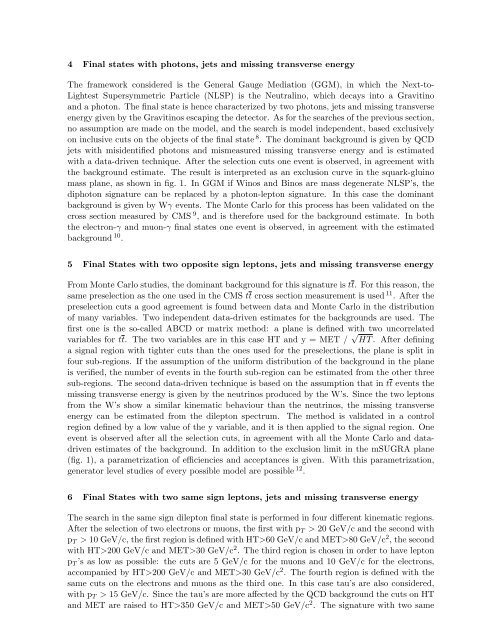2011 QCD and High Energy Interactions - Rencontres de Moriond ...
2011 QCD and High Energy Interactions - Rencontres de Moriond ...
2011 QCD and High Energy Interactions - Rencontres de Moriond ...
You also want an ePaper? Increase the reach of your titles
YUMPU automatically turns print PDFs into web optimized ePapers that Google loves.
4 Final states with photons, jets <strong>and</strong> missing transverse energy<br />
The framework consi<strong>de</strong>red is the General Gauge Mediation (GGM), in which the Next-to-<br />
Lightest Supersymmetric Particle (NLSP) is the Neutralino, which <strong>de</strong>cays into a Gravitino<br />
<strong>and</strong> a photon. The final state is hence characterized by two photons, jets <strong>and</strong> missing transverse<br />
energy given by the Gravitinos escaping the <strong>de</strong>tector. As for the searches of the previous section,<br />
no assumption are ma<strong>de</strong> on the mo<strong>de</strong>l, <strong>and</strong> the search is mo<strong>de</strong>l in<strong>de</strong>pen<strong>de</strong>nt, based exclusively<br />
on inclusive cuts on the objects of the final state 8 . The dominant background is given by <strong>QCD</strong><br />
jets with misi<strong>de</strong>ntified photons <strong>and</strong> mismeasured missing transverse energy <strong>and</strong> is estimated<br />
with a data-driven technique. After the selection cuts one event is observed, in agreement with<br />
the background estimate. The result is interpreted as an exclusion curve in the squark-gluino<br />
mass plane, as shown in fig. 1. In GGM if Winos <strong>and</strong> Binos are mass <strong>de</strong>generate NLSP’s, the<br />
diphoton signature can be replaced by a photon-lepton signature. In this case the dominant<br />
background is given by Wγ events. The Monte Carlo for this process has been validated on the<br />
cross section measured by CMS 9 , <strong>and</strong> is therefore used for the background estimate. In both<br />
the electron-γ <strong>and</strong> muon-γ final states one event is observed, in agreement with the estimated<br />
background 10 .<br />
5 Final States with two opposite sign leptons, jets <strong>and</strong> missing transverse energy<br />
From Monte Carlo studies, the dominant background for this signature is tt. For this reason, the<br />
same preselection as the one used in the CMS tt cross section measurement is used 11 . After the<br />
preselection cuts a good agreement is found between data <strong>and</strong> Monte Carlo in the distribution<br />
of many variables. Two in<strong>de</strong>pen<strong>de</strong>nt data-driven estimates for the backgrounds are used. The<br />
first one is the so-called ABCD or matrix method: a plane is <strong>de</strong>fined with two uncorrelated<br />
variables for tt. The two variables are in this case HT <strong>and</strong> y = MET / √ HT . After <strong>de</strong>fining<br />
a signal region with tighter cuts than the ones used for the preselections, the plane is split in<br />
four sub-regions. If the assumption of the uniform distribution of the background in the plane<br />
is verified, the number of events in the fourth sub-region can be estimated from the other three<br />
sub-regions. The second data-driven technique is based on the assumption that in tt events the<br />
missing transverse energy is given by the neutrinos produced by the W’s. Since the two leptons<br />
from the W’s show a similar kinematic behaviour than the neutrinos, the missing transverse<br />
energy can be estimated from the dilepton spectrum. The method is validated in a control<br />
region <strong>de</strong>fined by a low value of the y variable, <strong>and</strong> it is then applied to the signal region. One<br />
event is observed after all the selection cuts, in agreement with all the Monte Carlo <strong>and</strong> datadriven<br />
estimates of the background. In addition to the exclusion limit in the mSUGRA plane<br />
(fig. 1), a parametrization of efficiencies <strong>and</strong> acceptances is given. With this parametrization,<br />
generator level studies of every possible mo<strong>de</strong>l are possible 12 .<br />
6 Final States with two same sign leptons, jets <strong>and</strong> missing transverse energy<br />
The search in the same sign dilepton final state is performed in four different kinematic regions.<br />
After the selection of two electrons or muons, the first with pT > 20 GeV/c <strong>and</strong> the second with<br />
pT > 10 GeV/c, the first region is <strong>de</strong>fined with HT>60 GeV/c <strong>and</strong> MET>80 GeV/c 2 , the second<br />
with HT>200 GeV/c <strong>and</strong> MET>30 GeV/c 2 . The third region is chosen in or<strong>de</strong>r to have lepton<br />
pT ’s as low as possible: the cuts are 5 GeV/c for the muons <strong>and</strong> 10 GeV/c for the electrons,<br />
accompanied by HT>200 GeV/c <strong>and</strong> MET>30 GeV/c 2 . The fourth region is <strong>de</strong>fined with the<br />
same cuts on the electrons <strong>and</strong> muons as the third one. In this case tau’s are also consi<strong>de</strong>red,<br />
with pT > 15 GeV/c. Since the tau’s are more affected by the <strong>QCD</strong> background the cuts on HT<br />
<strong>and</strong> MET are raised to HT>350 GeV/c <strong>and</strong> MET>50 GeV/c 2 . The signature with two same








![List of participants 27/2/09 [pdf] - Rencontres de Moriond - IN2P3](https://img.yumpu.com/17975746/1/190x135/list-of-participants-27-2-09-pdf-rencontres-de-moriond-in2p3.jpg?quality=85)







